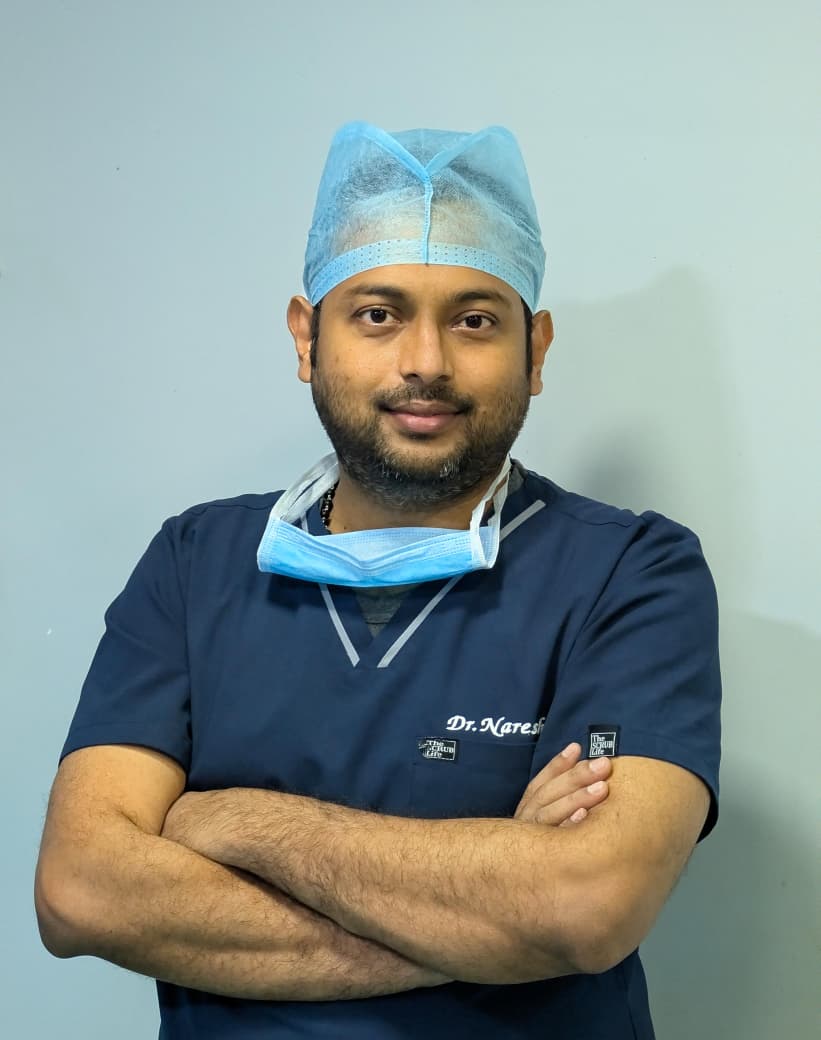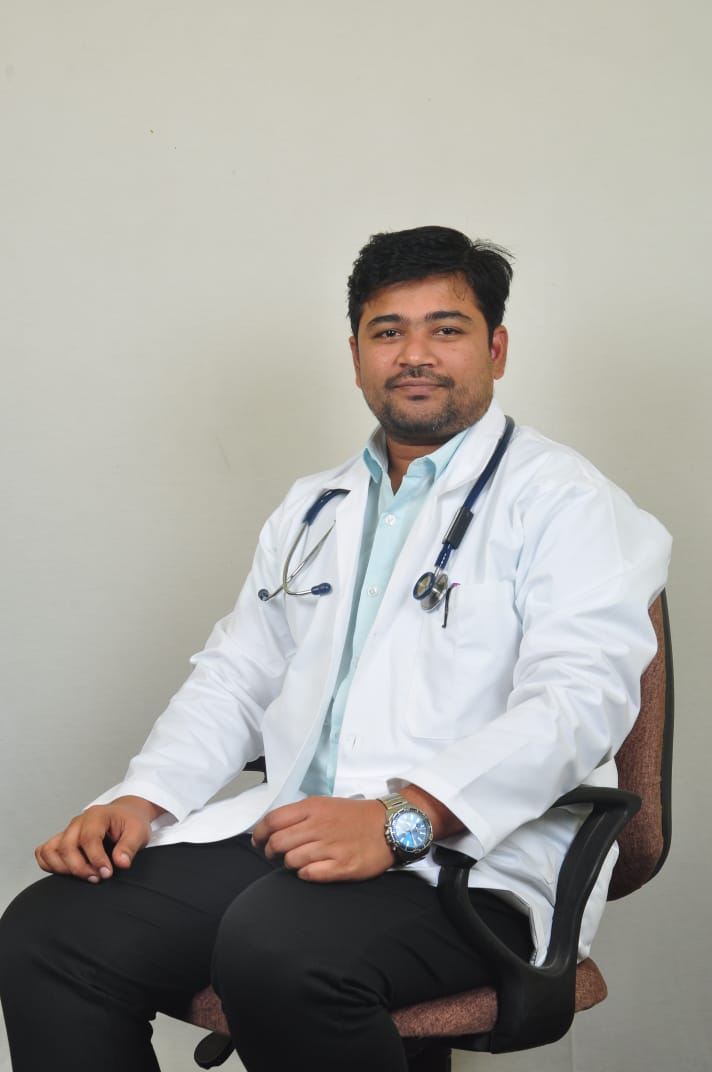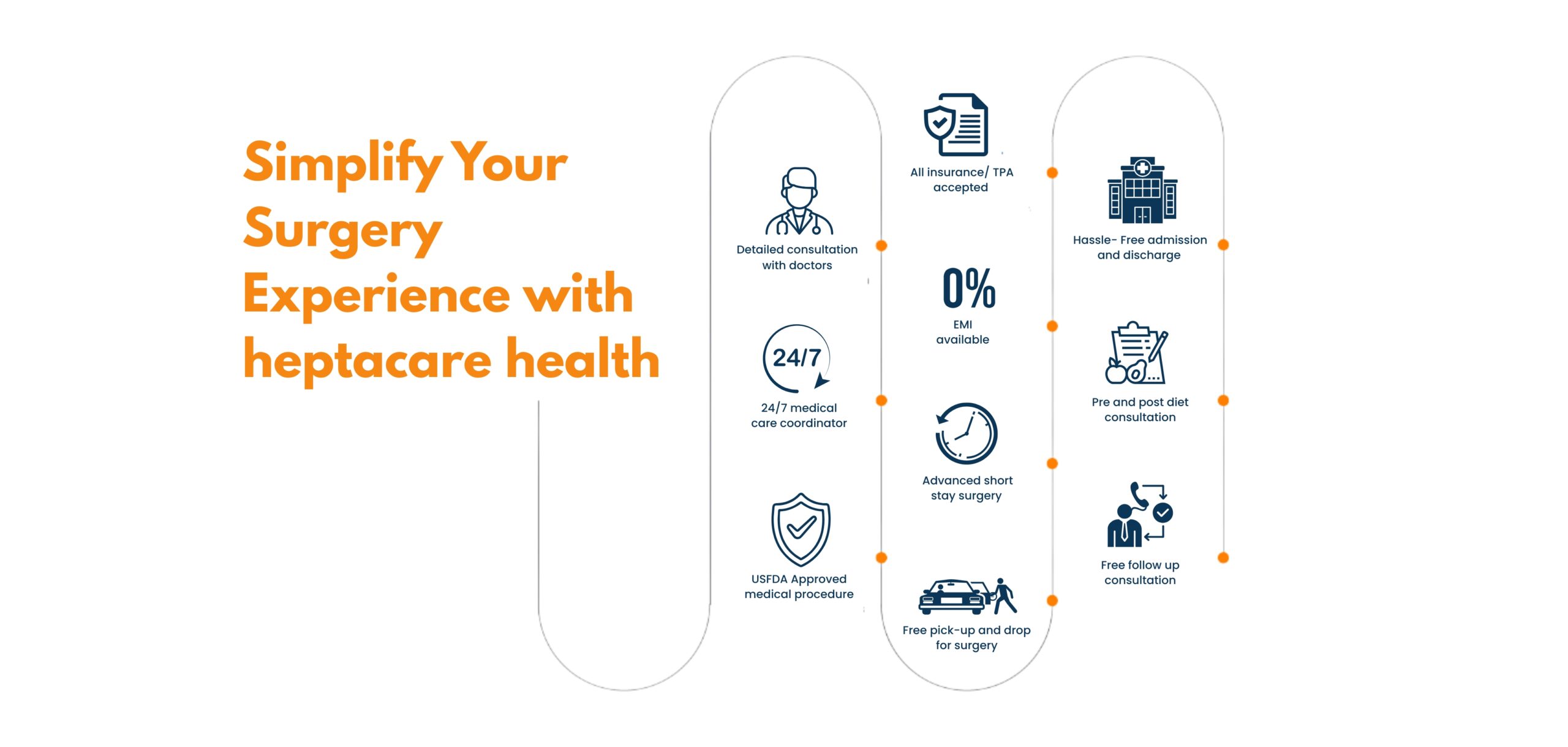A sebaceous cyst is a small, noncancerous lump beneath the skin caused by blocked sebaceous glands, often filled with oily or keratin material.
A tummy tuck is one of the most effective methods to get a flatter and more defined tummy (abdomen). If you wish to get rid of the excess fat and skin from the tummy region, get in touch with HeptaCare Health and consult our expert plastic surgeons to plan tummy tuck surgery. Get advanced and safe treatment under the care of our expert surgeons. Book a consultation today.
Happy Patients
Disease
Hospitals
Cities
Tummy tuck is a surgery that flattens the abdomen by removing extra fat and skin and tightening muscles in the abdominal wall and the waistline. Your waistline plays a significant role in your physical appearance. Excessive fat accumulation, sagging skin, and poor elasticity, or weakened connective tissue in the abdomen can affect the appearance of your waistline.
A tummy tuck could be an effective treatment for a person who has invested an extensive amount of time in reducing stubborn fats from the abdomen but sees no positive outcomes. Although most people confuse the treatment with liposuction, the two procedures are different. However, one may get liposuction and a tummy tuck.
A tummy tuck, also known as abdominoplasty or belly fat reduction surgery, is becoming an increasingly common plastic surgery, with around 1,50,000 surgeries performed yearly. In 2020, around 28,566 tummy tuck procedures were performed in India successfully.
There are various types of tummy tuck surgery, and each of them allows the surgeon to focus on specific body parts to deliver the best outcome in terms of contouring and reshaping the abdominal region. People who wish to undergo tummy tuck can choose among the following options to get the desired results.
The suitability of each type of tummy tuck surgery depends on individual factors, such as the extent of the concern, the amount of loose skin and fat, and the patient’s overall health. The plastic surgeon determines the most appropriate technique based on the individual’s specific needs.
Tummy tuck surgery, or abdominoplasty, is typically considered by individuals who have specific concerns related to their abdominal area. Here are some factors that may indicate that someone should consider a tummy tuck:
It’s important to understand that tummy tuck is a major surgery and should be considered after consulting a certified and experienced plastic surgeon.
Before undergoing a tummy tuck surgery, a thorough evaluation and diagnosis are necessary to ensure that the procedure is appropriate and safe for the individual. Here are some key aspects of the diagnosis process:
The surgeon will discuss the individual’s goals and expectations to determine the safest and most effective treatment plan. Before proceeding, the surgeon also advises the patient to maintain a stable weight. Women are asked about their family plans and recommended that they don’t get the surgery if they are planning to get pregnant in the near future as it can compromise the results of the treatment.
Tummy tuck means tucking the tummy region to make it look thin and flat. The procedure involves the removal of excess body fat and skin to restore the weakened and separated muscles of the abdominal profile. Many people relate the procedure to abdominal liposuction, which is an entirely different procedure. That’s why it is important to learn about the procedure.
A tummy tuck offers several benefits to individuals who are seeking to improve the appearance and contour of their abdominal area. Here are some of the key benefits:
Here are some of the essential points that the patient needs to keep in mind while preparing for a tummy tuck surgery:
The patient should also prepare the home for the recovery period. He/she will likely need ice packs, loose and comfortable clothing, a bathroom chair, petroleum jelly, etc., while resting and healing at home.
There are several factors that contraindicate the patient’s eligibility for a tummy tuck or abdominoplasty. Based on the following factors, the doctor may recommend the patient to avoid abdominoplasty:
Many people believe that anyone can undergo cosmetic surgery. However, this is not true. There are many factors that are standardized by the medical board that put the patient’s overall well-being above their wishes. Thus, considering the above-mentioned criteria, the doctor may deem the patient unfit or uneligible for tummy tuck surgery.
There are different types of tummy tuck, and the steps of each may differ slightly from the other one:
Full tummy tuck
A mini tummy tuck ideally addresses the lower abdomen or the area below the belly button. The steps of a mini tummy tuck involve:
An extended tummy tuck can be an effective treatment for patients that have lost substantial weight and are looking for a treatment that can refine the contours of the stomach and flanks.
In general, a tummy tuck will take around 2-3 hours to complete. But the exact duration will vary for different types of tummy tuck surgery.
Immediately after the surgery, the patient will be kept under observation for a couple of hours. The surgical site will be covered with an elastic bandage or a compression garment to reduce the swelling.
Small tubes or drains will also be placed under the skin to drain excess blood or fluid that may collect after the surgery. Besides these, the patient can expect-
The surgery is performed on an outpatient basis which means the patient will get discharged on the same day. Before discharge, the doctor will provide a detailed recovery guide with specific instructions that the patient must follow for optimal results.
Like any surgical procedure, tummy tuck surgery has potential side effects and risks. While the side effects are temporary and resolve within a few days or weeks, some patients may experience serious complications that may require further intervention.
To reduce the risk of complications after a tummy tuck, it’s crucial to choose an experienced plastic surgeon. He/she will identify the potential risks and take the necessary measures to mitigate them.
The tummy tuck recovery timeline varies for each patient depending on the extent of the procedure and the patient’s healing abilities. Typically, a patient will need around 4 to 6 weeks to recover completely after a full tummy tuck and 3 to 4 weeks after a partial or mini tummy tuck.
The tummy would be swollen and bruised immediately after the surgery. The patient needs to wear a compressive corset during this time. After getting home, the patient should get plenty of rest for the first few days to allow for proper healing. Here are a few dos and don’ts that a person needs to follow during recovery.
The postoperative diet following a tummy tuck surgery (abdominoplasty) plays a crucial role in the healing process and overall recovery. Here are some general dietary guidelines that are often recommended by the doctor:
These dietary guidelines will help to improve the body’s healing abilities to make the recovery quick and smooth.
The average cost of tummy tuck surgery in India ranges from Rs. 150500 to Rs. 250000. The exact cost of the treatment varies for each patient due to the following factors-
All these factors influence the cost of Tummy Tuck Surgery. To get a closer estimate, it’ll be best to have a consultation with an experienced plastic surgeon and get an estimate of abdominoplasty surgery cost in India.
While a traditional tummy tuck surgery (abdominoplasty) is an effective way to address excess skin and muscle laxity in the abdominal area, there are also non-surgical options available for individuals who prefer a less invasive approach. Here are some non-surgical tummy tuck options:
Body Contouring Treatments Non-surgical body contouring treatments can help tighten the skin and reduce fat in the abdominal area. These treatments use various technologies to target and reduce fat cells and stimulate collagen production. Some popular body contouring treatments include:
Injectable treatments like dermal fillers and injectable skin tighteners can help improve the appearance of the abdominal area. Dermal fillers can add volume to sunken or hollow areas, while injectable skin tighteners stimulate collagen production and improve skin elasticity.
While non-surgical options can provide some improvement, they may have limitations compared to a surgical tummy tuck. The results may be more subtle and temporary, and they may not be suitable for individuals with significant excess skin or muscle laxity. In such cases, tummy tuck surgery will be more suitable for the individual.


Based on 7721 Recommendations | Rated 4.68 Out of 5
Happy Patients
Clinics
Cities
Surgeries
Doctors
Hospitals

A beard transplant is a cosmetic procedure that restores or enhances facial hair by transplanting hair follicles from the scalp to the beard area.

Vaginoplasty is a surgical procedure that tightens or reconstructs the vaginal canal to improve function, appearance, or both.

Treat anal fistula with safe, advanced procedures.
Minimally invasive care with faster recovery.

A breast lump is a swelling or mass in the breast that can be benign (non-cancerous) or, in some cases, a sign of breast cancer.

A tummy tuck, or abdominoplasty, is a cosmetic surgery that removes excess fat and skin from the abdomen and tightens the muscles for a flatter, firmer tummy.

A double chin is a layer of excess fat beneath the chin, often caused by weight gain, ageing, or genetics, and can be reduced through cosmetic treatments or lifestyle changes.

A sebaceous cyst is a small, noncancerous lump beneath the skin caused by blocked sebaceous glands, often filled with oily or keratin material.

A lipoma is a soft, benign lump made up of fatty tissue that grows slowly under the skin and is usually painless and harmless.

Liposuction is a cosmetic surgery that removes excess fat deposits from specific body areas to improve body shape and contour.

Lipomas are soft, moveable, and grow slowly; imaging may confirm.
No, lipomas usually remain or grow slowly over time.
They can be removed by surgery, liposuction, or sometimes steroid injections.
Yes, some people inherit a tendency to develop multiple lipomas.
● lipoma laser surgery cost in Vizag ● low-cost lipoma surgery in Hyderabad ● cashless lipoma treatment near me ● painless lipoma surgery in Vijayawada ● lipoma treatment with insurance in Vizag ● lipoma removal surgery cost in Hyderabad ● lipoma operation packages in Vijayawada ● affordable lipoma treatment near me ● lipoma laser treatment clinic in Hyderabad ● lipoma doctor consultation charges in Vizag ● best lipoma surgery cost in Vijayawada ● lipoma treatment hospital near me ● lipoma laser operation price in Hyderabad ● low-cost lipoma laser treatment in Vizag ● lipoma removal cost near me ● lipoma treatment with EMI in Vijayawada ● lipoma surgery specialist near me ● lipoma surgery packages in Hyderabad ● lipoma treatment clinic near me ● lipoma laser surgery near me
Disclaimer: **The result and experience may vary from patient to patient.. ***By submitting the form or calling, you agree to receive important updates and marketing communications.
Getting an accurate diagnosis can be one of the most impactful experiences that you can have.

cure with care
Copyright © 2025. All rights reserved.
Consult with our expert surgeon for more than 50+ diseases
Happy Patients
Hospitals
Cities